Bonhams breaks world record yet again for Japanese work of art in third part of Edward Wrangham sale
A silver lacquer four-case inro By Koma Kansai, after a design by Sakai Hoitsu, 19th century realised £85,250 against a pre-sale estimate of £20,000 – 25,000. Photo: Bonhams.
LONDON.- The world record for inro (traditional Japanese case consisting of nested boxes) sold at auction has been broken yet again by Bonhams in the third and final part of the Edward Wrangham sale that took place on the 15th May. With a sale total of £1.7 million, 82% sold by lot and 93% by value, one of the most important private collections of Japanese works of art has realised £5.4 million across the three sales held at Bonhams.
Considered one of Europe’s most important and comprehensive private collections of Japanese Gentleman’s accessories, it was formed by the late environmentalist, mountaineer, scholar and collector Edward Wrangham OBE.
The top lot of the sale, and a world record for the artist sold at auction, was a lacquer single case inro by the master of the Meiji Period, Shibata Zeshin that sold for £301, 250, exceeding the presale estimate of £20,000 – 30,000 by over ten times. In a sale with very competitive bidding, when this lot hit £150,000, a private client on the telephone increased the bid by £100,000, to secure the much coveted inro. This was the third time that Bonhams has broken the record for works by Shibata Zeshin at auction.
A lacquer single-case inro. By Shibata Zeshin (1807-1891), Meiji Period. Photo Bonhams
Of rectangular form, deocorated in brown, black andkasshoku (dark, burnt-orange) takamakie, with a large persimmon fruit and two kurosuguri (blackberries) falling to the ground on one side, a small trailing branch of kurosugurion the reverse, the calyx and branches skillfully rendered to create a realistic and textured surface which contrasts against the smooth, glossy lacquer finish of the over-ripe fruit, all reserved on a dark brown seido-nuri ground, the interior of plain roiro lacquer, signed on the base with scratched characters Zeshin. 6.6cm x 4.7cm (2 9/16in x 1 13/16in). Sold for £301,250
柿に黒酸塊図蒔絵印籠 銘「是真」 明治時代
Provenance: W. L. Behrens collection, no.1091, illustrated in the Catalogue, pl.XLVIII.
Wrangham collection, no.1535.
This is a typical and classic example of lacquer work by the artist - the seido or bronze-style ground often favoured by Zeshin provides an elegant and subdued canvas for this understated still-life design whilst the sombre colours of blackish-brown, black and dark, burnt-orange symbolises the visual representation of the aesthetic ideal iki (roughly translating as nonchalant chic) that the cultured, wealthy and taste-conscious urbanites of Edo society and indeed, Zeshin himself, strove to emulate.
According to Fujioka Sakutaro (1870-1910), an art historian, whose Kinsei Kaigashi (History of Painting in Recent Times), first published in 1903, the hallmarks of haiku can be used to characterize Zeshin's greatest and most distinctive works. He observed that by deliberately choosing to paint a few things so that they seem to overflow beyond the edges of the paper, Zeshin achieved the same emotional impact as the haikumaster does with his 17-syllable verses - interestingly, among his many artistic and literary talents, Zeshin himself was also an accomplished haiku poet.
Colin Sheaf, Director of the Asian Art department commented ”Once again, the powerful attraction of an exceptional private collection, presented in a well researched and superbly illustrated catalogue, generated very high auction bidding from American, European and Japanese museum and private buyers. Even at times of economic uncertainty in the wider financial markets, a coterie of established and financially secure buyers continue to dominate a sophisticated sector of the global art market.”
Top prices were also realised for inro by other artists including a stunning 19th century, lacquer four-case inro by Koma Kansai after a design by Sakai Hoitsu. The inro depicted two crows perched on a snow-covered twisted trunk of a pine and realised £85,250 against a pre-sale estimate of £20,000 – 25,000. In Japan, the crow is considered an auspicious bird and is often depicted by artists. It is said that Kansai identified personally with the bird.
A silver lacquer four-case inro. By Koma Kansai, after a design by Sakai Hoitsu, 19th century. Photo Bonhams
Of upright form, bearing a fine rogin-nuri ground, lacquered insumie and slight-coloured togidashi with two crows perched on a snow-covered, twisted trunk of a pine tree, with the pale disc of the rising sun behind, the reverse with a peony growing from a rice stook, lacquered in similar style and the interior of rich nashiji, signed Hoitsu hitsu with seal, Koma Kansai utsusu; with red glass ojime. 10.2cm (4in). Sold for £85,250
入り日に雪枝鴉図蒔絵印籠 銘「古満寛哉寫」「抱一筆 (方印)」 19世紀
Provenance: Pangibaud collection, sold at Portier, Paris, 1972.
Michael Birch collection, purchased at Sotheby's, London, 1980.
Wrangham collection, no.1474.
Exhibited: Meiji: Japanese Art in Transition, Gemeentemuseum, The Hague, Holland, 1987, no.142.
In Japan, the crow is considered an auspicious bird and is often depicted by a number of artists, including Shibata Zeshin (1807-1891), Watanabe Seitei (1851-1918) and not least, Kawanabe Kyosai (1831-1889) who became known especially for his crow paintings and prints, repeating the subject frequently. Not only did the artist have exceptional knowledge of the character of his subject but he even identified personally with the bird.
Many clients were prepared to secure pieces from this collection, reflected in the final prices realised, which often far exceeded the presale estimates. An 18th century black lacquer three-case inro by Ogawa Haritsu, inlaid with a flaming drum, sold for £56,650 (est. £8,000 – 10,000) and a rare, brown lacquer ink-cake three-case inro by Kengen, from the school of Ogawa Haritsu sold for £46,850 (est. £7,000 – 8,000).
A black lacquer three-case inro. By Ogawa Haritsu (Ritsuo, 1663-1747), 18th century. Photo Bonhams
In the form of a Chinese ink-cake, lacquered and inlaid with a flaming drum and a four-character inscription in gold and slight-coloured takamakie, enamelled pottery and aogai, the reverse with a two-character inscription within a border of musical instruments and formal motifs, the interior of black lacquer, signed with seal Kan. 7.9cm (3 1/8in). Sold for £51,650
古墨意匠舞楽太鼓図蒔絵螺鈿陶片貼付印籠 銘「觀(方印)」 18世紀
Provenance: Louis Gonse collection.
Purchased from Eskenazi Ltd., London, 1971.
Wrangham collection, no.1113.
Published: Gaston Migeon, Chefs-d'Oeuvre d'Art Japonaise, 1905, no.303.
The International Netsuke Society Journal, vol.14, no.3, p.33, fig.19.
The inscription on the reverse is taken from an illustration in a Chinese woodblock-printed book by Fang Yulu, titled Fang Shi Mopu, 'A compendium of Chinese ink-cake designs', published circa 1588, and also introduced by Cheng Dayue in 1606.
A rare brown lacquer ink-cake-shaped three-case inro. By Kengen, School of Ogawa Ritsuo, 18th century. Photo Bonhams
Of rectangular form, the entire surface of mottled-brown lacquer, engraved with crackle to simulate age, carved on one side with a crane flying over a warbler perched in a pine tree, enclosed within a circular medallion, the reverse with a three-line Chinese poem in a rectangular panel, on one narrow side is an inscription Taiitsu shin'ichi no sumi (in Chinese, Taiyi zhenyi zhi mo) (the finest ink in the universe) and on the other, the signature of the calligrapher, Hosoi Kotaku with seal; the interior of plain lacquer, signed in seal form Kengen. 7.6cm (3in). Sold for £46,850
濃茶色古炭意匠松に鶴図印籠 銘「建元(方印)」 18世紀
Provenance: Jacques Carré collection, purchased from Barry Davies Oriental Art, London, 2000.
Wrangham collection, no.2177.
The poem transcribes:
鶴日福禄壽閣
鶯日樹草生闕
萬暦乙酉立春日
And translates:
"The crane bespeaks the hall of good fortune, rank and longevity,
The warbler bespeaks the gate of living trees and plants", with the date Wanli, the year of the rooster, beginning of Spring (1585).
The Japanese calligrapher and Confucian scholar, Hosoi Kotaku (1658-1735) was a contemporary of Ogawa Haritsu (Ritsuo), the first Japanese lacquerer to make inro in imitation of Chinese ink-tablets. With their mutual interest in Chinese studies, it seems also likely that Kotaku and Haritsu might have known each other.
Further highlights of the sale included an inlaid brown lacquer two-case inro by Jika Ganbun that sold for £44,450 (est. £3,000 – 5,000), an unusual gold lacquer four-case by Mototada that sold for £39,650 (est. £10,000 – 15,000) and a rare brown lacquer three-case inro by Yamada Yokasai sold for £32,450 (est. £4,000 – 4,500).
An inlaid brown lacquer two-case inro. By Jikan Ganbun, 19th century. Photo Bonhams
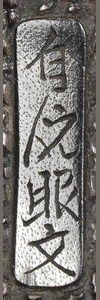 In the form of a pouch, the brown lacquer ground carved to simulate leather, decorated with a snail and ants crawling over a gourd vine, with details inlaid in pewter, silvered-metal and copper, the design extending over the top, the interior ofnashiji, signed in a black lacquer, rectangular reserve Jikan Ganbun; with stag-antler ojime in the form of an apple inlaid with a ladybird crawling over the skin, unsigned. 5.8cm (2¼in). Sold for £44,450
In the form of a pouch, the brown lacquer ground carved to simulate leather, decorated with a snail and ants crawling over a gourd vine, with details inlaid in pewter, silvered-metal and copper, the design extending over the top, the interior ofnashiji, signed in a black lacquer, rectangular reserve Jikan Ganbun; with stag-antler ojime in the form of an apple inlaid with a ladybird crawling over the skin, unsigned. 5.8cm (2¼in). Sold for £44,450
たばこ入れ意匠瓢箪に蝸牛図蒔絵貼付彫金印籠 銘「自侃眼文」 19世紀
Provenance: Aoyama, Paris.
Daniel Rouvière collection, purchased at Hotel Drouot, via Alain Ducros, Paris, 1991.
Wrangham collection, no.2053.
Published: Alain Ducros, Netsuke et Sagemono, Paris, 1987, p.190.
E. A. Wrangham, The Index of Inro Artists, 1995, p.56, Ganbun, second from left.
A gold lacquer unusual four-case inro. By Mototada, 19th century. Photo Bonhams
 In the shape of an oi (a Yamabushi priest's travelling pack), of slightly-domed and curved rectangular form, bearing afundame ground with a simulated basketwork and wood structure and with trailing ivy on both sides in gold and slight-coloured takamakie, the corners strengthened with silver and interior of nashiji, signed Mototada with kao. 10.2cm (4in). Sold for £39,650
In the shape of an oi (a Yamabushi priest's travelling pack), of slightly-domed and curved rectangular form, bearing afundame ground with a simulated basketwork and wood structure and with trailing ivy on both sides in gold and slight-coloured takamakie, the corners strengthened with silver and interior of nashiji, signed Mototada with kao. 10.2cm (4in). Sold for £39,650
笈形竹網戸図蒔絵印籠 銘「基薫(花押)」 19世紀
Provenance: Baron Morimasa Takei collection, no.5.F.18.
Purchased from Spink & Son Ltd., London, 1993.
Wrangham collection, no.2045.
Published: E. A. Wrangham, The Index of Inro Artists, 1995, p.187, Mototada, centre.
Exhibited: Treasures of the North, Whitworth Art Gallery, Manchester, and Christie's, London, 2000, no.57.

/https%3A%2F%2Fprofilepics.canalblog.com%2Fprofilepics%2F1%2F0%2F100183.jpg)
/https%3A%2F%2Fstorage.canalblog.com%2F03%2F02%2F119589%2F96711876_o.jpg)
/https%3A%2F%2Fstorage.canalblog.com%2F11%2F31%2F119589%2F94773502_o.jpg)
/https%3A%2F%2Fstorage.canalblog.com%2F20%2F83%2F119589%2F94772815_o.jpg)
/https%3A%2F%2Fstorage.canalblog.com%2F26%2F72%2F119589%2F75604929_o.jpg)
/https%3A%2F%2Fstorage.canalblog.com%2F59%2F60%2F119589%2F26458628_o.jpg)









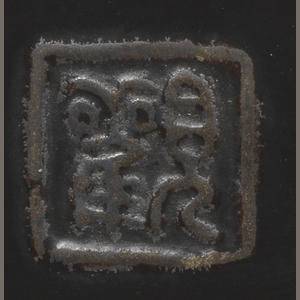
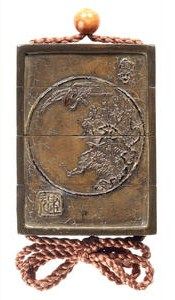
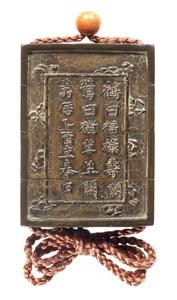



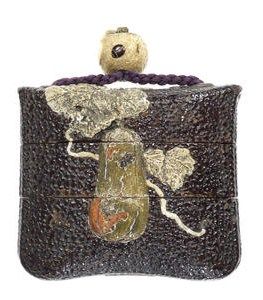




/http%3A%2F%2Fstorage.canalblog.com%2F13%2F37%2F119589%2F129550780_o.jpg)
/http%3A%2F%2Fstorage.canalblog.com%2F47%2F91%2F119589%2F110611313_o.jpg)
/http%3A%2F%2Fstorage.canalblog.com%2F36%2F15%2F119589%2F110611160_o.jpg)
/http%3A%2F%2Fstorage.canalblog.com%2F22%2F38%2F119589%2F110611054_o.jpg)